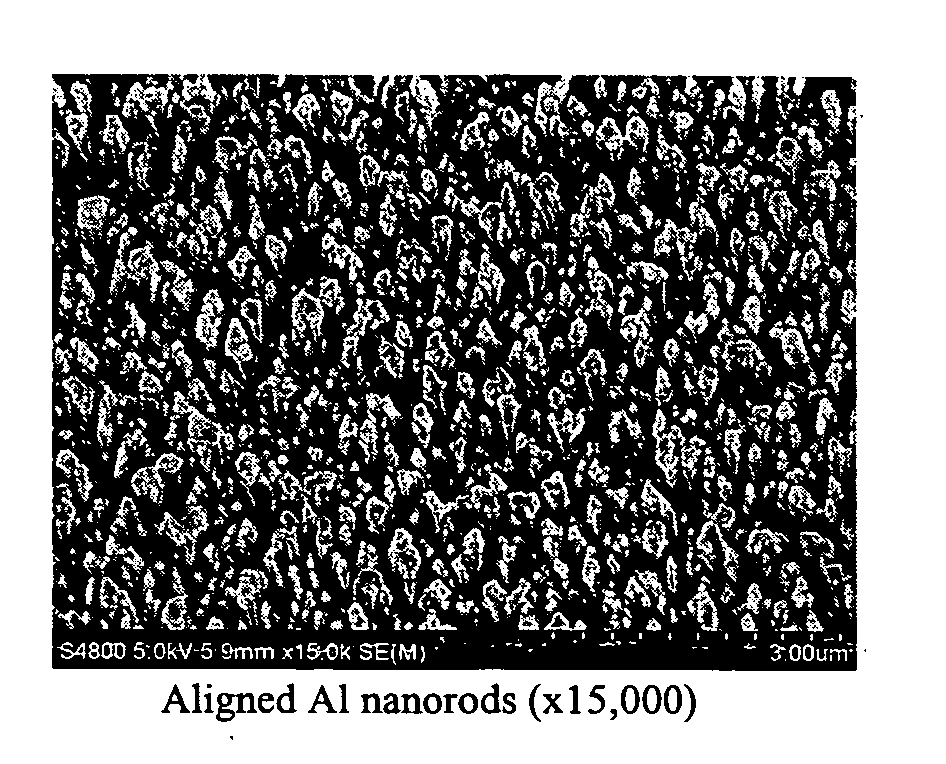Free standing nanostructured metal and metal oxide anodes for lithium-ion rechargeable batteries
a rechargeable battery and free-standing technology, applied in the manufacture of electrodes, cell components, transportation and packaging, etc., can solve the problems of battery failure, limit the power density of the battery, material pulverization, etc., and achieve the effect of reducing stress and prolonging cycle li
- Summary
- Abstract
- Description
- Claims
- Application Information
AI Technical Summary
Benefits of technology
Problems solved by technology
Method used
Image
Examples
example 1
[0039]A thin film of aluminum nanorods were grown on a titanium substrate using vapor deposition as set forth on the accompanying FIGS. 1 and 2. The average diameter and length of the Al rods are 100 nanometers and 0.5 micrometers respectively. Electron dispersion spectroscopy analysis confirmed the nanorods are pure aluminum.
[0040]The lithium / aluminum nanorod cell, consisting of an aluminum nanorod anode and a lithium cathode and as referred to hereafter as Li / Al nanorods was tested for its electrochemical storage capacity and found to have a first discharge capacity of 1243 mAh / g from 3 volts to 0.01 volts at 10 mA / g. That discharge capacity is 4 times greater than the 372 mAh / g of carbon anodes and is illustrated in reference to FIG. 5.
[0041]As seen in FIG. 3, the anode discharge capacity in a second discharging is 440 mAh / g. However, the discharge capacity was decreased to 100 mAh / g after only ten cycles (FIG. 5). It was found that the deposition layer of the Al nanorods was del...
example 2
[0042]A thin film of aligned aluminum nanorods were grown on a copper substrate using vapor deposition as set forth on the above. The average diameter and length of the rods were measured at 100 nanometers and 0.5 micrometers respectively. The Li / Al nanorod cell was tested for its electrochemical storage capacity and found to have a first discharge capacity of 1243 mAh / g from 3 volts to 0.01 volts at 10 mA / g. The discharge capacity was maintained at 400 mAh / g after ten charge-discharge cycles (FIG. 7). The improvement of cyclic stability attributes to strong adhesion of aluminum and copper because Al can be dissolved in Cu and form alloys such as Li9Al4. The deposition layer well connected with copper substrate after ten cycles (FIG. 8).
example 3
[0043]A thin film of aligned Co3O4 nanorods was grown on a titanium substrate as illustrated on FIGS. 9A and 9B. X-ray diffraction confirmed the Co3O4 formation (FIG. 10) and scanning electron microscopy reveals the Co3O4 formed a thin film consisting of hollow nanorods with an average diameter of 70 nanometers and a length of 200 nanometers (FIG. 11). The majority of the nanorods were perpendicularly grown from the titanium substrate with a hollow channel open to the exterior. This morphologic feature is believed to greatly facilitate the motion of lithium ions. The Li / Co3O4 nanorod cell demonstrated 2484 mAh / g discharge capacity from 2.7 V to 0.01 V and was recharged to 3 V with 1433 mAh / g rechargeable capacity in the first cycle. The reversible capacity of Li / Co3O4 nanorod cell was five time higher than carbon anode (FIG. 12).
[0044]While the examples described herein are related to anode nanostructures, it is recognized that similar nanostructures can be applied to cathode struct...
PUM
| Property | Measurement | Unit |
|---|---|---|
| thickness | aaaaa | aaaaa |
| diameter | aaaaa | aaaaa |
| length | aaaaa | aaaaa |
Abstract
Description
Claims
Application Information
 Login to View More
Login to View More - R&D
- Intellectual Property
- Life Sciences
- Materials
- Tech Scout
- Unparalleled Data Quality
- Higher Quality Content
- 60% Fewer Hallucinations
Browse by: Latest US Patents, China's latest patents, Technical Efficacy Thesaurus, Application Domain, Technology Topic, Popular Technical Reports.
© 2025 PatSnap. All rights reserved.Legal|Privacy policy|Modern Slavery Act Transparency Statement|Sitemap|About US| Contact US: help@patsnap.com



